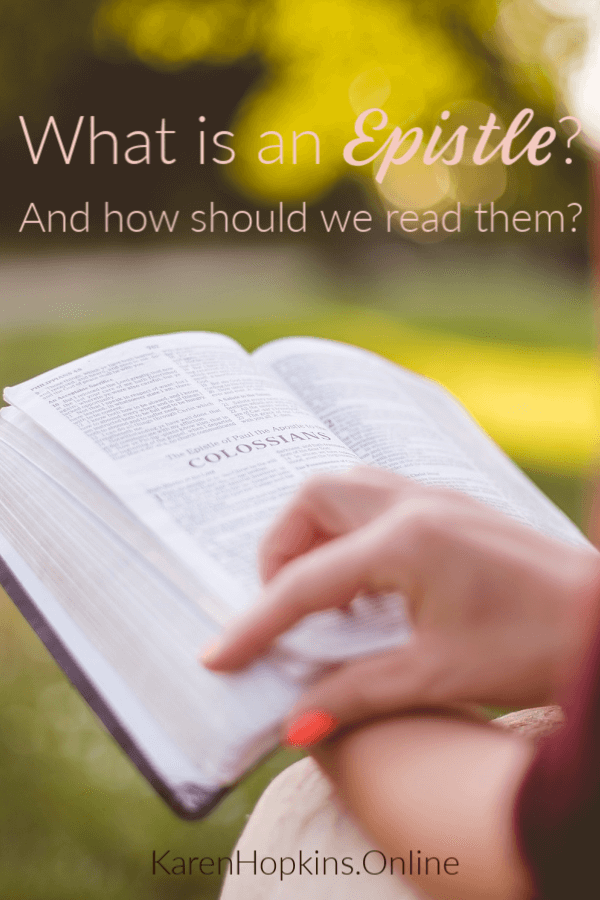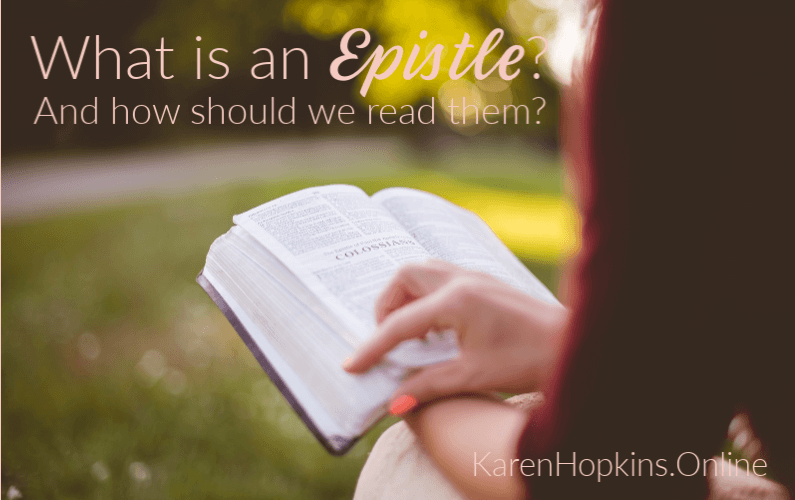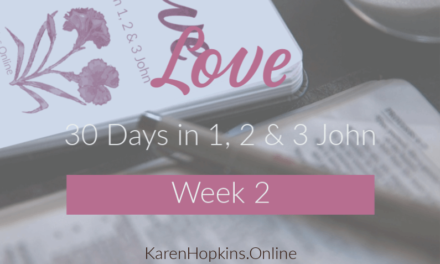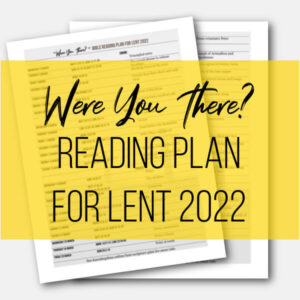Since we have a number of Scripture Plans on Epistles (listed below), I thought it was time we had a look at a few questions about Epistles: What is an Epistle? And how should we read Epistles? Are there different things we need to take into consideration when studying an Epistle to any other book or genre in the Bible?
First, here’s the list of our Scripture Plans on Epistles:
Unless otherwise stated the Scripture References are taken from the Christian Standard Bible. While referring to lots of different versions in my study, I generally use the CSB Study Bible for Women on kindle.
What is an Epistle?
An epistle is a formal letter written to an individual or group of people, often with the intent of sharing with others. It was a common form of communication during Ancient Egypt and New Testament times. An Epistle often contained religious or moral instructions.
New Testament Epistles
There are 21 Epistles in the New Testament. This list of Epistles, shows how they are arranged in the Bible, coming after the Gospels and Acts, and before Revelation.
| Epistle | Writer | Recipient | Date |
| Romans | Paul | Church in Rome | A.D. 57 |
| 1 Corinthians | Paul | Church in Corinth | A.D. 53, 54 or 55 |
| 2 Corinthians | Paul | Church in Corinth | A year later than 1 Corinthians |
| Galatians | Paul | Believers in Galatia |
A.D. 48 |
| Ephesians | Paul | Church in Ephesus | A.D. 62 |
| Philippians | Paul | Church in Philippi | A.D. 62 |
|
Colossians |
Paul | Christians in Colossae | A.D. 62 |
| 1 Thessalonians | Paul | Church in Thessalonica | A.D. 49-51 |
| 2 Thessalonians | Paul | Church in Thessalonica | A.D. 49-51 |
| 1 Timothy | Paul | Timothy | A.D. 64-65 |
| 2 Timothy | Paul | Timothy | A.D. 64-67 |
| Titus | Paul | Titus |
mid 60s A.D. |
| Philemon | Paul | Philemon |
A.D. 62 |
| Hebrews | Unknown | Jewish Christians | Before A.d. 70 |
| James | James (brother of Jesus) | Jewish Christians outside Palestine | A.D. 40-45 |
| 1 Peter | Peter | Christians scattered in modern Turkey | A.D. 62-63 |
| 2 Peter | Peter | Possibly church in Asia Minor | A.D. 64-67 |
| 1, 2 & 3 John | John | Possibly to churches mentioned in Revelation | Before A.D. 90 |
| Jude | Jude (brother of Jesus) | Jewish Christians | Mid 60’s A.D. |
Paul’s Epistles
Some of Paul’s epistles have also been grouped into two smaller groups:
- 1 and 2 Timothy and Titus are called the Pastoral Epistles, as they are addressed to leaders in the church, giving advice on how to lead.
- Ephesians, Philippians, Colossians and Philemon are known as the Prison Epistles as they were written when Paul was under house arrest in Rome.
Related:
How to Understand the Bible for Beginners
Why are there four Gospels?
How to read an Epistle
Now let’s get to our next question: How do we read an Epistle? I’m going to use the stages of my 5L Bible Study Method (Letter, Look, Learn, Live, Love) and focus on what’s important when reading an Epistle. (The Study Guides I write to accompany the Scripture Plans are written using this format so you get my notes, and space to write your own, for all the steps.)
Bible Study Bookmarks

Download the set of three Bible Study Bookmarks and keep them in your Bible ready to refer to when needed.
The bookmarks give you instructions for my 5L Bible Study Method, tips for doing a verse mapping, and what to look for when reading the Bible.
Epistles are also letters from God to us
I’ve called the first stage of my 5L Bible Study Method ‘Letter’ to remind us we are reading God’s word to us, but when reading an Epistle we are also reading an actual letter written by someone to another person or people. In order to properly understand and interpret what is being said we need to research the background to the Epistle. We need to ask ourselves these questions:
- Who wrote it and why?
- Who were they writing too?
- What is their background?
It is important to know the answers to these questions as they do vary. Some epistles were written to encourage and some to correct. We should be able to find the answers to these questions in the introduction to the letter of a Study Bible like The Study Bible For Women or the ESV Study Bible.
What to look for when reading an Epistle
Now it is time to read the text. As with any other letter we receive, it is a good idea to read it through from start to finish. Many of the epistles are short enough that this can be done quite quickly. You could use a different version of the Bible than you usually use.
Then take a closer look at what it says. Epistles often contain specific instructions, or imperatives, take note of these and determine if they are general instructions that you should also follow or specific instructions for the recipients of the letter.
Other words to take note of particularly in the Epistles are transition words or phrases like ‘so that’, ‘therefore’, ‘for’, and ‘although’. It is helpful to draw an arrow or line in your Bible or notes to connect these words with the ideas to identify the themes and see the progression or contrasts. For example, note all the ‘If we’ phrases in 1 John 1:6-10. Three times ‘If we…’ is followed with ‘we are/have’ but the forth ‘If we..’ is followed by ‘He is’. I believe that noticing this pattern makes it all the more powerful.
If we say, “We have fellowship with him,” and yet we walk in darkness, we are lying and are not practising the truth. If we walk in the light as he himself is in the light, we have fellowship with one another, and the blood of Jesus his Son cleanses us from all sin. If we say, “We have no sin,” we are deceiving ourselves, and the truth is not in us. If we confess our sins, he is faithful and righteous to forgive us our sins and to cleanse us from all unrighteousness. If we say, “We have not sinned,” we make him a liar, and his word is not in us.
Related: How to read the Bible Effectively
How to learn more about the Epistle we are reading
Once we have studied the text for ourselves we can then look outside the text to learn more.
The first place to look is other parts of the Bible. Use the cross references and foot notes of your Study Bible to help you find events in Acts that relate to the letter (Paul’s missions), other writings (John’s Gospel and his Epistles) and Old Testament or Gospel references.
Then refer to Bible Study notes, commentaries or Bible dictionaries for historical and cultural understanding. It is important that we have understood the context in which the writing was set before we go to the next stage – personal application.
This post contains affiliate links, which means that for each purchase made I receive a small contribution at no extra cost to you. For more information please see my policies page.
Will our reading of the Epistle change how we live?
Every time we study the Bible we should include some personal application. What responses should we make to what we have read in the Epistle?
Sometimes with the Epistles it is easy to identify what that should be. Remember those imperatives we looked for?
Let all bitterness, anger and wrath, shouting and slander be removed from you, along with all malice. And be kind and compassionate to one another, forgiving one another, just as God also forgave you in Christ. Ephesians 4:31-32
But sometimes we may need to use the knowledge we have gained from our reading and research (as well as the work of the Holy Spirit) to decide upon an appropriate application. And sometimes the application may simply be to praise God.
Blessed be the God and Father of our Lord Jesus Christ. Because of his great mercy he has given us new birth into a living hope through the resurrection of Jesus Christ from the dead and into an inheritance that is imperishable, undefiled, and unfading, kept in heaven for you. 1 Peter 1:3-4
Look for God’s love in the Epistle, and respond in love.
As always with any Bible reading, ask yourself how it fits into the Big Picture of the Bible message – Creation, Fall, Redemption, Restoration. What does this passage of Scripture tell us about the Trinity and our relationship with God?
And remember to conclude with prayer, thanking and praising God for his word, his love, his forgiveness, and asking him to help you with any challenges or applications you have decided upon.
One final note…
All these steps may seem daunting, but don’t let them be. Take as much time as you want, spread out the steps over a few days if you want to, and remember to pray and allow the Holy Spirit to speak to you.











Trackbacks/Pingbacks